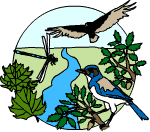 |
MISSION CREEK
SHRUBS
and
FLOWERING PLANTS |
|
|
|
|
Apiaceae (Parsley
Family) |
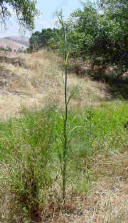  Fennel Fennel
Foeniculum vulgare
NON NATIVE
A perennial herbaceous plant with umbels of tiny yellow flowers with
dark green thin leaves. Introduced from Eurasia. Dried fennel
fruits are used as a spice. Leaves and stalks can be eaten
like a vegetable. Has a sweet, aromatic taste similar to
licorice or anise.
|
|
 Poison
Hemlock Poison
Hemlock
Conium maculatum
NON NATIVE
Poison Hemlock is a
perennial herb, 1-2 meters tall. The stems are smooth and
hollow with a characteristic red mottling. Leaves are compound,
lacy, and alternate. The small white flowers are borne in
compound umbels at the top of the stalk. The taproot is small
and white with a disagreeable smell. All plant parts are
poisonous. The seeds contain the most poison, a piperidine
alkaloid. Socrates is reputed to have been killed by being
forced to drink the juice of this plant.
|
|
Apocynaceae (Perwinkle Family) |
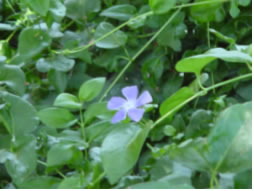 Big
leaf Perwinkle Big
leaf Perwinkle
Vinca major
NON NATIVE
Herbaceous, evergreen with
oval, glossy, green leaves in an opposite arrangement. The plant
spreads on the ground and forms dense masses. Flowers are purple to
white and have 5 parts. |
|
Araceae (Arum Family)
|
|
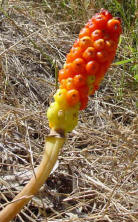 Jack-in-the pulpit Jack-in-the pulpit
Arisaema triphyllum
NON NATIVE
Perennial,
herbaceous plant about 65 cm in height. The plant has basal leaves
only. Each leaf is divided into 3 equal parts. Flowers are green
with purple-brown stripes. Fruit is a cluster of bright shiny, red
berries. Found in moist, shaded areas. Native to eastern United
States. Indians used for medicinal purposes from snakebites to
arthritis. However, no part of the plant should be eaten.
|
|
Araliaceae (Ginseng Family) |
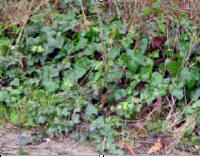 Algerian
ivy Algerian
ivy
Hedera canariensis
NON NATIVE
A fast growing ground
cover that likes shade. It is fast growing and invasive. Leaves
are alternate and simple. Leaves are lobed with variegated green
color. It is an evergreen. |
|
Asteraceae (Sunflower Family)
|
|
 Yarrow Yarrow
Achillea millefolia
NATIVE
Herbaceous
perennial that produces one to several stems. Leaves are found
toward the bottom of the stems. The compound leaves are fern-like
with leaflets that are bipinnate. The flower heads have a flattened
dome shape with approximately 10-20 yellowish-white ray flowers with
5 petals. They are drought tolerant.
|
|
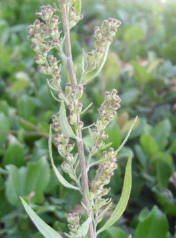 Mugwort Mugwort
Artemisia douglasiana
NATIVE
Mugwort is a
meter tall perennial, with a distinctive odor that is found along
the stream banks. It blooms from June to October . Leaves are
long and grayish green in color. The common name of “mugwort” comes
from a European species used as a condiment (seasoning). The name is
derived from the old English name for plant “wort” and a container
“mug.” The European herb may have been used as a flavoring in a
beverage consumed from a mug.
|
|
 Coyote Brush Coyote Brush
Baccharis pilularis
NATIVE
Coyote brush
is an evergreen shrub that grows up to 4 meters in this area. Male
and female flowers are borne on separate plants in late fall. The
yellow pollen of the male flower smells like shaving soap. Early
Californians, because of its abundant silky-haired seeds, called
coyote brush “fuzzy-wuzzy”. Coyote brush is an important pioneer
species in the process of plant succession. It is usually the first
shrub to appear in a grassy field after vegetation has been removed
by cultivation or fire.
|
|
Caprifoliaceae (Honeysuckle Family)
|
|
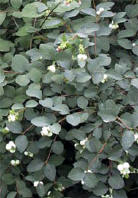 Snowberry Snowberry
Symphoricarpos
rivularis
NATIVE
A deciduous shrub 1-3 meters high and spreads
by suckers. Produces a small pink bell shaped, 5 petalled flower
that are hairy inside. Berries mature in autumn and are white and
globe shaped.
|
|
Fabaceae (Pea
Family) |
|
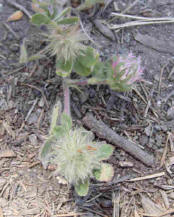 Clover Clover
Trifolium sp.
NON NATIVE
Perennial,
legume, stems erect, leaves of basal rosette. Leaves are palmately
compound with 3 leaflets. Flowers are 10-15 mm long, rosy purple to
creamy white. Peduncle and calyx are hairy. Can grow on wet or
dry meadows and be used as feed for cattle.
|
Garryaceae (Silk Tassel Family)
|
 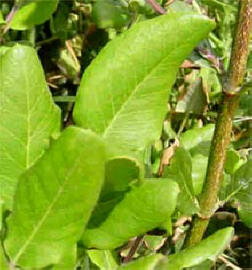 Coast Silk-tassel Coast Silk-tassel
Garrya elliptica
NATIVE
Evergreen shrubs or small trees.
Leaves are leathery with wavy edges. They are arranged in opposite
pairs and are dark shiny green above; gray below with dense,
microscopic hairs. Male and female catkins are borne on separate
plants. The male catkin is long with slender chains of “bells.”
|
|
Grossulariaceae (Gooseberry Family)
|
|
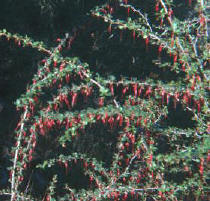 Fushia Flowering Currant Fushia Flowering Currant
Ribes speciosum
NATIVE
In late winter this plant is covered with drooping clusters of pink
flowers. Fruit maturation following pollination brings berries that
the birds enjoy. It is found in many habitats from the North Coast
and Outer North Coast Ranges to the Outer South Coast
|
|
Rhamnaceae (Buckthorn Family)
|
 Blue Blossum Blue Blossum
Ceanothus thyrsiflorus
NATIVE
Shrubs or
small trees, with white to blue flowers that are small but showy.
The terminal inflorescence varies with each species The leaves are
evergreen, alternating, and are oval in shape. There are 43 species
native to California from the coast to the Sierras.
|
 Italian Buckthorn Italian Buckthorn
Rhamnus alaternus
NON NATIVE
This
evergreen shrub has an irregular upright form with a dense canopy.
Medium height about 5-7 meters with a spread of about 5 meters.
Leaves are dark green, serrated, glossy, and oval about 5 cm in
length. It is valued as a tough, low-maintenance street tree.
Appropriate beneath overhead wires. Disease and pest resistant and
attracts birds.
|
 Coffee Berry Coffee Berry
Rhamnus californica
NATIVE
Low lying,
medium to large evergreen shrub, found in the Coast Ranges. Coffee
berry bears black fruits that gives the name of coffee berry to most
species. Clusters of berries are green, ripening to orange-red and
finally black. The young leaves are lighter green and mature to dark
green. Edges curl under during dry summers to conserve moisture.
Flowers are white with a star shape, emerging from green buds in
clusters.
|
|
Rosaceae (Rose Family)
|
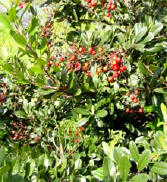 Toyon Toyon
Heteromoles arbutifolia
NATIVE
Large
evergreen shrub or small tree, 1.8-3 meters tall. It has brilliant
red berries in the winter. Leaves are dark green, serrated. Flat
cluster of small white flowers. Drought tolerant plant.
|
|
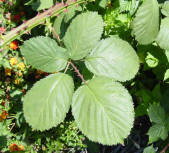 Himalayan
Blackberry Himalayan
Blackberry
Rubus discolor
NON-NATIVE
Himalayan blackberry is an Asian species that has been cultivated
for its large berries. The stems bear large, stout spines. Its
leaves are divided into 5 large leaflets that are silvery on the
underside. It spreads rapidly in riparian areas and crowds out more
desirable native vegetation.
|
|
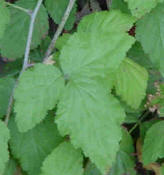 California Blackberry California Blackberry
Rubus ursinus
NATIVE
California blackberry is a low-growing arching shrub that roots
where stems touch the ground. The stems are covered with weak
prickles. Its leaves are divided into 3 slender, spiny leaflets
that are green on both surfaces. White to pink flowers are followed
by small berries that are ripe when deep, dull black.
|
|
Scrophulariaceae (Figwort Family)
|
 Sticky monkey flower Sticky monkey flower
Diplacus aurantiacus
NATIVE
Size is about
40 cm, erect sub-shrub. Sometimes it has a sprawling growth. It
has a deep orange flower that blooms in early summer. Leaves are
2-8 cm, dark green and resinous above. Occurs in foothills and
coastal ranges north of Santa Barbara County. Drought resistant.
|
|
Tropaeolaceeae (Nasturtium Family) |
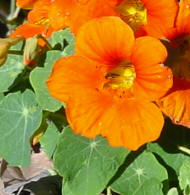 Nasturtium Nasturtium
Tropaeolum majus
NON NATIVE
Plants form a
low bush or trailing form 8-12 inches tall. Leaves are light green
and round while the bright flowers range from red, orange, and
yellow.
|
|
Urticaceae (Nettle Family) |
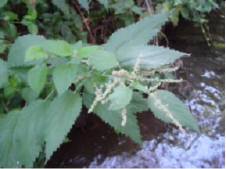 Stinging
Nettle Stinging
Nettle
Urtica diocica
NATIVE
Humans that
brush near a stinging nettle may get tiny hollow hairs from the
leaves that release formic acid which irritates the skin and causes
white itchy spots to appear. The plant grows as a large main stem.
The leaves are in opposite pairs and the flowers concentrate in
clusters from the leaf axils. The flowers do not have petals; male
flowers have a 4-lobed calyx and 4 stamens and the female flowers
are either 4-lobed or 2-lobed and have a pistil that produces a
single seed. |